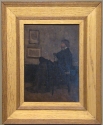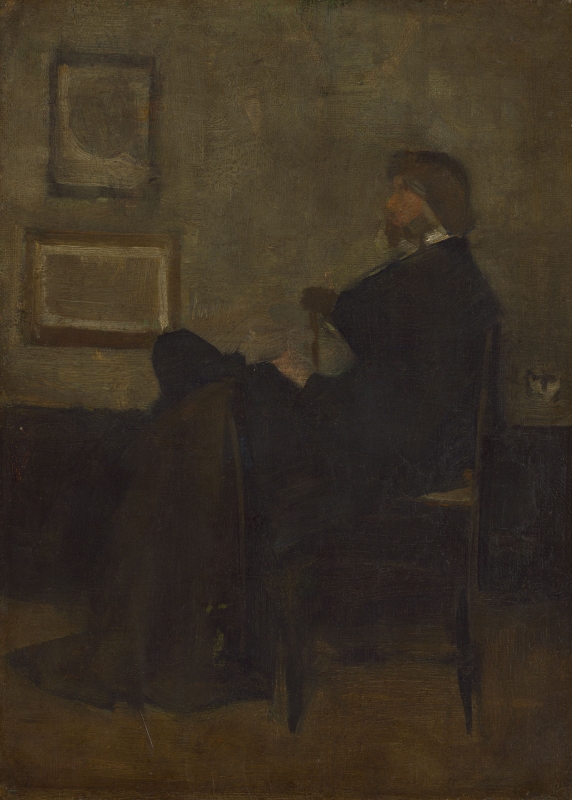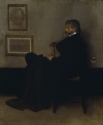Home > Catalogue > People > Thomas Carlyle (related works) > Catalogue entry
Composition
During technical analysis of this painting at the Art Institute of Chicago, an X-radiograph revealed that it was painted over a brightly coloured portrait, or possibly several sketches. One underlying sketch may represent a seated man facing forward, wearing a dark jacket and pale trousers, a hat held in his left hand, between his legs, or, alternately, a woman seated in profile to left, wearing a dark jacket and pale skirt, her left arm hanging at her side, holding a hat or bag. 1

Study for 'Arrangement in Grey and Black, No. 2: Portrait of Thomas Carlyle', Art Institute of Chicago
In colour and composition this work is almost exactly similar to the finished portrait of Thomas Carlyle (Arrangement in Grey and Black, No. 2: Portrait of Thomas Carlyle [YMSM 137]) and is presumably a preliminary sketch. It served mainly to give an idea of the composition and the colour harmonies that Whistler wanted to achieve.
Technique

Study for 'Arrangement in Grey and Black, No. 2: Portrait of Thomas Carlyle', Art Institute of Chicago
The medium and technique have been analysed by Kimberley Muir. Whistler painted the work on a plain-weave canvas prepared with a double ground layer. Both layers contain lead white and calcium carbonate, plus bone black in the upper layer. Whistler's brushes measured .5, 1, and 1.5 cm wide. 2
It was painted over an earlier composition, and traces of the earlier brushwork and scraping are visible, as well as, at the edges of the canvas, traces of bright green, red, and blue. Muir adds, 'Pigments that appear to be related to the underlying composition include lead white, chrome yellow, iron oxide or earth pigments, vermilion, and ultramarine blue.' The pigments in the study of Carlyle, according to Muir, include lead white, iron oxide or earth pigments, and vermilion, often mixed with black pigment. 3
Muir comments:
'While the paint used for the Carlyle study is quite thinly applied in places, it has a paste consistency, and brush marks are visible throughout the surface. Areas of wet-in-wet mixing along the interface of the figure and the background indicate that Whistler worked back and forth between the subject and the surroundings and executed the work quite quickly.' 4
The portrait study of Carlyle is executed with loose brush strokes. The background wall, dado and floor are painted with short brush strokes that run in various directions. The brush follows the contours of the picture frames and Carlyle's body and clothes. The butterfly signature is roughly sketched in. Its inclusion underlines its relevance for the finished Arrangement.
Conservation History
The conservation and condition of the painting are discussed by Kimberley Muir in the Art Institute of Chicago online catalogue. The canvas has been lined. The painting, varnished with a natural-resin varnish, and despite areas of crinkling and cracking, is in good condition. 5
Frame
After 1872: the style and whereabouts of any original frame(s) are unknown.

Study for 'Arrangement in Grey and Black, No. 2: Portrait of Thomas Carlyle', Art Institute of Chicago
ca 1900: Flat Whistler frame, made in America. 6
Notes:
1: Kimberley Muir, “Cat. 15 Study for “Arrangement in Grey and Black, No. 2: Portrait of Thomas Carlyle,” 1872/73: Technical Summary,' in Whistler Paintings and Drawings at the Art Institute of Chicago, The Art Institute of Chicago, 2020, fig. 15.6. URL.
2: Muir, Kimberley, 'Cat. 15 Study for “Arrangement in Grey and Black, No. 2: Portrait of Thomas Carlyle,” 1872/73: Technical Summary,' in Whistler Paintings and Drawings at the Art Institute of Chicago, The Art Institute of Chicago, 2020, URL.
3: Muir 2020, ibid.
4: Muir 2020, ibid.
5: Muir 2020, ibid.
6: Dr Sarah L. Parkerson Day, Report on frames, 2017.
Last updated: 3rd December 2020 by Margaret






